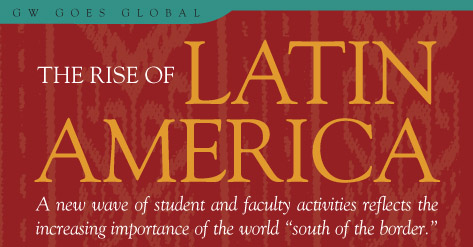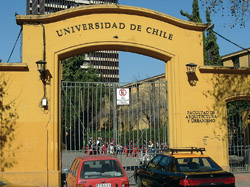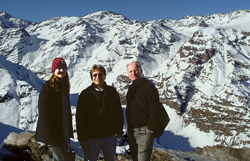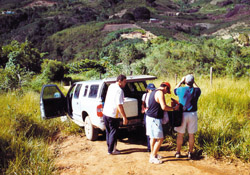|

By Louis Berney
Latin America is hot—and
not just when it comes to the weather.
GW has ratcheted up its Latin
American studies and research programs as student
and faculty interest has escalated in the United
States’ neighbors to the south. Joining
the University’s Elliott School of International
Affairs Latin American and Hemispheric Studies
program are new offerings in GW’s Columbian
College of Arts and Sciences and School of Business.

|

Campus Andres Bello
of the University of Chile, Santiago, Chile
|
Columbian College, for example, is developing
a new degree program in Latin American and Latino
literatures and cultures. Also, an increasing
number of GW students, both at the graduate and
undergraduate levels, are taking courses or specializing
in Latin America studies, as well as taking Spanish
language courses.
The School of Business is creating a focus on
Latin American studies. And more GW students than
ever are traveling to Latin American nations to
study. At the same time, GW is forging new relationships
with universities in countries such as Chile,
Peru, Brazil, and Argentina as it attempts to
open up a wider array of venues for students interested
in studying abroad. Additionally, the University’s
faculty members are conducting research on Latin
American themes, including governance and the
region’s role in international affairs.
What’s more, GW’s schools of medicine
and law also are engaged in projects that touch
the lives of people living in Latin American nations
and those who have moved to the United States.
Latin American Studies
Interest in learning about Latin America has
taken off. The number of students majoring in
Spanish at GW has tripled during the past five
years.
“There are hundreds of students who take
Spanish as their language requirement and dozens
who major in Spanish,” says Sergio Waisman,
associate professor of Spanish.
Similarly, as recently as three years ago, the
number of applicants seeking to enroll in GW’s
Latin American Studies Program was 25, according
to Jim Ferrer, associate research professor of
international business in the Elliott School,
who directed the program through July. Now, he
says, the number of applicants has more than doubled.
“The region is already becoming the major
trade area for the United States,” Ferrer
says, explaining why attention to Latin America
is booming at GW. “Also, we have a growing
U.S. population that traces its roots to Latin
America.”
Because of the hike in interest in Latin American
studies, the program has been adding new courses,
expanding its conference series, and is presenting
new opportunities for students to study abroad.
The program offers both undergraduate and graduate
degrees in Latin American and hemispheric studies.
Among the newer offerings are courses on immigration
and Latin American sociology, as well as classes
focusing on individual countries including Argentina,
Brazil, and Mexico, and the Andean region in general.
GW’s existing Latin American programs
may soon be augmented by a new program in the
Columbian College of Arts and Sciences that will
provide students with an opportunity to earn bachelor’s
and master’s degrees in Latin American and
Latino cultures and literatures. The emphasis
of the new program, currently in the planning
stages, will be on cultures and literatures.
The literary and cultural dimensions of the
new program will distinguish it from current course
offerings by infusing Latino culture and literature,
that is, culture evolving from America’s
own Latino community.
The impetus for the new program grew from the
recognition by CCAS officials that faculty members
were doing important research in Latin American
literatures and cultures and that the discipline
presented itself as an area of potential growth
for the University.
Waisman says the new literary and cultural initiative
will fill an important gap at GW. “It’s
an important area to study today,” he explains.
“It would reflect the changing demographics
in the United States and at GW. So it seemed like
a natural fit.”
Faculty Research
Cynthia McClintock, professor of political science
and international affairs, is one of GW’s
faculty members who specializes in Latin America—Peru,
in particular. As a recipient of the prestigious
Woodrow Wilson Center for International Scholars
fellowship, McClintock will continue to conduct
research on the implications of run-off election
procedures, as opposed to elections that rely
on pluralities, in the countries of Chile, Venezuela,
Peru, and Mexico. She points out that three decades
ago, all Latin American countries relied on pluralities
to decide national elections. Today, however,
a majority of the countries in the region hold
run-off elections instead. Her research is exploring
why the change occurred and what the impact is
“from a systemic perspective.” Her
research, one of several projects on Latin America
now being conducted by GW professors, will lead
to a preliminary report this fall and, she hopes,
a book next summer.
A former president of the international Latin
American Studies Association, McClintock says
the region is generating interest at GW and other
academic institutions in the United States. “Latin
American countries are our neighbors,” she
points out, “and because of that proximity,
there are all sorts of crucial relationships,
human and otherwise.”

Courtney Goike,
assistant director of GW's Office for Study
Abroad; Paul Duff, associate professor of
religon; and former CCAS dean William Frawley,
on a day trip near Farellones, a skiing
site near Santiago, Chile, during the Summer
2005 Global Scholars in Globalization program.
|

|
Like Ferrer, McClintock believes one reason Latin
America also holds appeal for GW students is because
of the economic relationships between the United
States and countries south of the border, spurred
by a dramatic increase in both exports and imports.
For students of international relations, political
science, and history, there’s also the issue
of national security. While much of the national
security interest today is focused on the Middle
East, McClintock recalls that the closest the
United States ever came to World War III likely
was the Cuban missile crisis of 1962, when the
United States and Russia sparred over Soviet missiles
located less than 100 miles south of Florida in
Cuba.
U.S. policymakers and students of global affairs
also can turn to Latin America for a blueprint
on how to transform autocratic states in the Middle
East into democracies, as the United States currently
is attempting to do in Iraq. “We can look
at these countries in Latin America that got their
starts as democracies about 20 years ago and are
well ahead of the Middle East,” McClintock
says. “We can see from them what lessons
can be learned.” Latin American democratization
efforts, she believes, can serve as “a kind
of prism to help see what went right and what
went wrong.” For example, the United States
intervened militarily in Panama in 1989, and a
democratic state emerged in that Central American
nation; the Panamanian experience can provide
insights for U.S. policy in Iraq and other Middle
Eastern countries.
Study Abroad
The University launched a center in the spring
of this year for students to study for a semester
or for a full academic year in Santiago, Chile.
GW has a similar program available in Buenos Aires,
Argentina.
This summer, 17 GW students spent five weeks
in Costa Rica in preparation for studying abroad
in the fall semester in either Santiago or Buenos
Aires. “We wanted to give our students a
sense of what’s important to Latin Americans
right now, as well as to help them be prepared
linguistically to go to one of the two partner
universities,” says Courtney Goike, assistant
director of GW’s Office for Study Abroad.
The classes in Costa Rica are all given in Spanish
so the GW students will be prepared to understand
more complex discussions when they arrive in Chile
and Argentina.
Goike says GW established the relationships with
institutions in Chile, Argentina, and Costa Rica
because, “the University saw a need to go
beyond Europe.” A report by a faculty committee
several years ago recommended that the University
establish study abroad centers first in London
and Paris and then in Latin America, with a program
to be initiated later in Asia. The idea was to
establish GW centers in foreign countries so the
University could ensure quality programs and at
the same time maximize the contributions of faculty
members to help enrich the experience of students
choosing to study out of the country.
Donna Scarboro, assistant vice president for
special and international programs, sees the GW
centers in Latin American countries dovetailing
with the Latin American programs presented on
campus. “The University recognizes the importance
of our Latin American neighbors and that our own
immediate community is influenced by relations
with Latin America and enriched by the culture
of Latin America,” she says.
Throughout the year, some graduate students
in the School of Business study in Chile and undergraduates
in Columbian College’s global scholars program
interact with Chilean students, first in Chile
and then in Washington, with a group of Chilean
students visiting GW.
Practical Applications
Another component of the University’s
involvement in Latin America involves the University’s
professional schools engaging in practical projects.

|

Workers prepare materials
at a hookworm vaccine research test site
in Minas Gerais, Brazil.
|
GW’s School of Medicine and Health Sciences
has been engaged for six years in developing a
hookworm vaccine to help eradicate a disease common
in rural regions of Latin American countries.
Peter Hotez, professor of microbiology and tropical
medicine and chair of the school’s microbiology
department, has been working with the Sabin Vaccine
Institute, with the help of an $18-million grant
from the Bill and Melinda Gates Foundation, to
develop a vaccine to combat the hookworm disease.
Much of the research was conducted in the school’s
laboratories. Now several vaccine candidates are
being administered in clinical trials in rural
Brazil by GW researchers and investigators on
behalf of the Sabin Institute under a second grant
from the Gates Foundation for $21.8 million.
Professor Jeffrey Bethony, a member of the medical
school faculty, currently is in Brazil and taking
leadership in coordinating the first phase of
the clinical trials of the larval stage vaccine
candidates, together with adjunct assistant professor
David Diemert. Bethony has pioneered clinical
immunological approaches to solving health problems
in the poorest regions of Minas Gerais State.
Hotez says GW and Sabin are working to transfer
the vaccine process development technology to
Instituto Butantan in Sao Paolo, Brazil, a state-owned
vaccine manufacturer. These efforts are being
headed by Gaddam Goud, a research professor, and
Maria Elena Bottazzi, an associate research professor,
as well as GW staff members Aaron Miles, Vehid
Deumic, and Jordan Plieskatt. Finally, Bottazzi
is heading up outreach efforts in Honduras, Panama,
and elsewhere in Central America.
At GW Law School, students handle immigration
cases under the guidance of Alberto Manuel Benitez,
professor of clinical law and director of the
school’s Immigration Clinic. A great majority
of the clinic’s cases involve immigrants
from Latin American countries. In fact, Benitez
says, immigrants from virtually every country
in Latin America have been represented by the
clinic in the 10 years he has been at GW.
“We always have way more clients and potential
clients than we can possibly represent,”
he says.
Through the Immigration Clinic, frequently GW
is the first institution some of the immigrant
clients have had contact with since entering the
United States. “The GW Immigration Clinic
always strives to perform in a professional manner,”
Benitez says. “We hope that they can see
how things are done here and hopefully that can
be adaptable. And if the clients talk with their
friends and neighbors in Latin America, it can
increase the profile of GW.”
The clinic receives cases from immigration judges,
other attorneys, immigration agencies, friends
and neighbors of immigrants, and from previous
clients who were pleased with their representation
by the GW clinic.
Because participation in the Immigration Clinic
is voluntary, interested students must apply and
be admitted by Benitez. This spring, of the seven
students who worked with Benitez in the clinic,
five spoke Spanish, an advantage in serving clients
who may understand little or no English.
“I tend to get dedicated, motivated students,”
Benitez explains. “They are here because
they want to be here.” And even more significantly,
he adds, the students have been quite successful
in their representation of Latin American aliens.
“The results have been excellent,”
he says.
From law to medicine, from culture to business,
from linguistics to study abroad, from faculty
research to South and Central American students
coming to GW, the University’s interest
and involvement in Latin America is significant—and
continues to grow. Just this summer the Elliott
School’s Ferrer visited Brazil to negotiate
with two universities to establish new exchange
programs for business students. The distance between
GW and countries south of the U.S. border seems
to shrink almost daily as the University broadens
its Latin American ties.
Louis Berney, BA ’72, is a Baltimore-based
freelance writer.
|